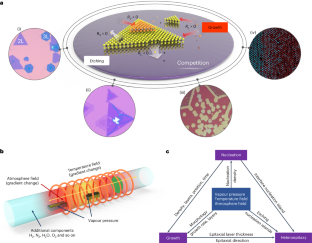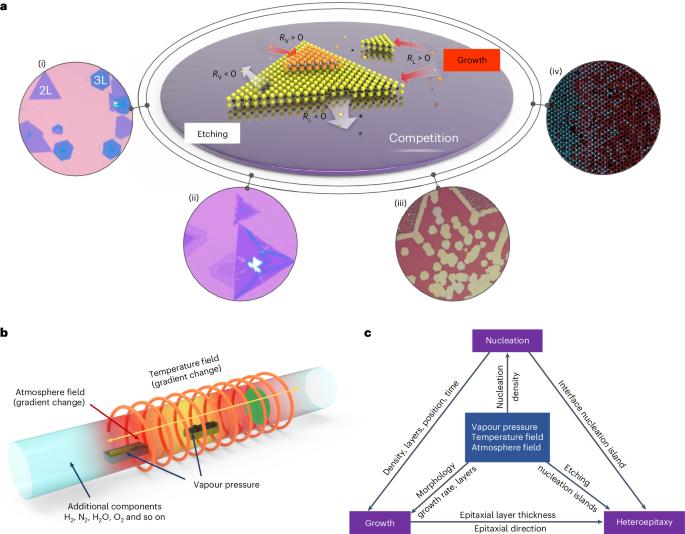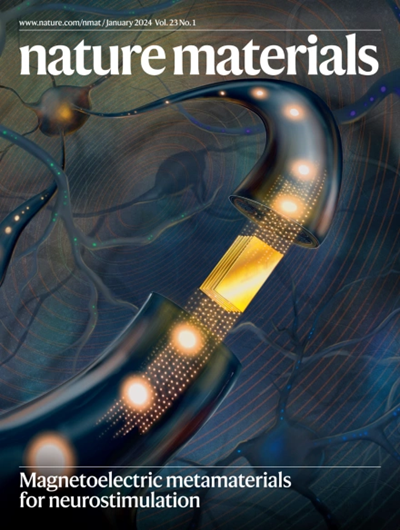超越剥离和重新堆积,实现二维异质结构和超晶格的可扩展合成
IF 37.2
1区 材料科学
Q1 CHEMISTRY, PHYSICAL
引用次数: 0
摘要
二维过渡金属二钙化物具有原子级薄的几何形状和无悬键表面,在各种技术应用(包括亚纳米尺度的超微型晶体管)方面引起了人们的浓厚兴趣。直接的剥离和堆叠方法已被广泛用于各种二维(2D)异质结构、超晶格和摩尔超晶格的近乎任意的组装,为奇异物理现象的基础研究和概念验证设备演示提供了一个多功能的材料平台。虽然这种方法为近年来二维材料研究的蓬勃发展做出了重要贡献,但它显然不适合实用技术。要充分发挥二维过渡金属二掺碲化物的潜力,就必须通过对化学成分和电子结构进行可设计的空间调制,对这些原子般薄的材料及其异质结构进行稳健、可扩展的合成。极高的长宽比、缺乏本征基底以及原子级薄晶体的高度易损性给材料合成带来了根本性的困难。在此,我们总结了基于过渡金属二钴化物的异质结构、超晶格和摩尔超晶格的可扩展合成所面临的主要挑战,强调了当前的进展,并概述了其中的机遇。本文章由计算机程序翻译,如有差异,请以英文原文为准。


Towards the scalable synthesis of two-dimensional heterostructures and superlattices beyond exfoliation and restacking
Two-dimensional transition metal dichalcogenides, which feature atomically thin geometry and dangling-bond-free surfaces, have attracted intense interest for diverse technology applications, including ultra-miniaturized transistors towards the subnanometre scale. A straightforward exfoliation-and-restacking approach has been widely used for nearly arbitrary assembly of diverse two-dimensional (2D) heterostructures, superlattices and moiré superlattices, providing a versatile materials platform for fundamental investigations of exotic physical phenomena and proof-of-concept device demonstrations. While this approach has contributed importantly to the recent flourishing of 2D materials research, it is clearly unsuitable for practical technologies. Capturing the full potential of 2D transition metal dichalcogenides requires robust and scalable synthesis of these atomically thin materials and their heterostructures with designable spatial modulation of chemical compositions and electronic structures. The extreme aspect ratio, lack of intrinsic substrate and highly delicate nature of the atomically thin crystals present fundamental difficulties in material synthesis. Here we summarize the key challenges, highlight current advances and outline opportunities in the scalable synthesis of transition metal dichalcogenide-based heterostructures, superlattices and moiré superlattices. The practical application of 2D transition metal dichalcogenides (TMDs) requires robust and scalable synthesis of these atomically thin materials and their heterostructures. This Review discusses the key challenges, current progress and opportunities in the controllable synthesis of TMD-based heterostructures, superlattices and moiré superlattices.
求助全文
通过发布文献求助,成功后即可免费获取论文全文。
去求助
来源期刊

Nature Materials
工程技术-材料科学:综合
CiteScore
62.20
自引率
0.70%
发文量
221
审稿时长
3.2 months
期刊介绍:
Nature Materials is a monthly multi-disciplinary journal aimed at bringing together cutting-edge research across the entire spectrum of materials science and engineering. It covers all applied and fundamental aspects of the synthesis/processing, structure/composition, properties, and performance of materials. The journal recognizes that materials research has an increasing impact on classical disciplines such as physics, chemistry, and biology.
Additionally, Nature Materials provides a forum for the development of a common identity among materials scientists and encourages interdisciplinary collaboration. It takes an integrated and balanced approach to all areas of materials research, fostering the exchange of ideas between scientists involved in different disciplines.
Nature Materials is an invaluable resource for scientists in academia and industry who are active in discovering and developing materials and materials-related concepts. It offers engaging and informative papers of exceptional significance and quality, with the aim of influencing the development of society in the future.
 求助内容:
求助内容: 应助结果提醒方式:
应助结果提醒方式:


